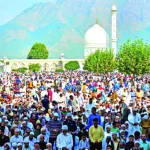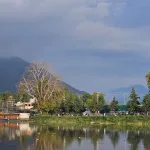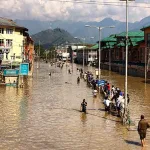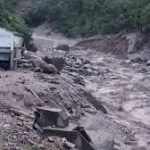Chairs high-level meeting on flood situation in Kashmir
SRINAGAR, SEPT 05: Chief Minister Omar Abdullah today chaired a high-level meeting to review the flood situation in the Kashmir Valley, focusing on rescue, relief, and rehabilitation measures.
Addressing the meeting, the Chief Minister directed immediate reinforcement of embankments at vulnerable spots, evacuation of residents from inundated areas, and round-the-clock monitoring through control rooms. He emphasised frequent field visits, timely public advisories urging people to stay alert and avoid panic, and maintaining calm among residents.
The Chief Minister instructed that evacuees must be provided uninterrupted relief, law and order maintained through close coordination with the police, and any attempts at rumour-mongering countered swiftly.
Calling the next 48 to 72 hours “critical,” he said: “The level of vigilance currently being maintained must continue until the water recedes fully. Our teams must stay fully active on the ground, with continuous monitoring of bunds. Any leakages or breaches must be addressed immediately. While the respite from rainfall has improved the situation, we cannot afford complacency.”
He also stressed the importance of assessing damage for targeted relief and compensation. “Deputy Commissioners must carry out realistic assessments of damage to property, agricultural land, and public infrastructure. These reports will form the basis for seeking assistance from the Government of India.”
To support immediate relief efforts, the Chief Minister announced the release of ₹5 crore from the UT CapEx budget, in addition to available funds under the State Disaster Response Fund (SDRF).
The meeting was attended by Deputy Chief Minister Surinder Kumar Choudhary, Minister for Health & Medical Education Sakina Itoo, Minister for Jal Shakti Javed Ahmad Rana, Advisor to the Chief Minister Nasir Aslam Wani, Chief Secretary Atal Dulloo, Additional Chief Secretaries to the CM, Jal Shakti and Agriculture Production departments, Divisional Commissioner Kashmir, Administrative Secretaries, senior police officials, Chief Engineers of KPDCL, KPTCL, I&FC, PHE, R&B, BEACON, and SAMPARK, Commandants of SDRF and NDRF, Director of the India Meteorological Department Kashmir, RO NHAI J&K, State-Level Coordinator IOCL J&K, among others. Outstation officials participated via video conferencing.
The Divisional Commissioner Kashmir briefed the meeting on water levels at Sangam, Ram Munshi Bagh, and Asham, confirming that the Jhelum river has receded below the danger mark. Joint teams from the Irrigation and Flood Control (I&FC) Department, police, and other agencies are patrolling vulnerable embankments and reinforcing them with sandbags. Inundated villages in Shalina are witnessing receding waters, and relief measures are underway for displaced families.
On the restoration front, officials reported that water supply schemes are functioning with only minor disruptions, while power, telecom, and healthcare services remain largely unaffected. Essential supplies are being routed through the Mughal Road, which has temporarily become the Valley’s lifeline. The Srinagar-Jammu National Highway (NH-44) is expected to reopen by tomorrow, with fruit-laden trucks currently being cleared in phases via the Mughal Road.
Deputy Commissioners from all Valley districts provided ground reports confirming a receding trend in the Jhelum’s tributaries, including the Lidder, Vaishow, Sandran, and Rambi Ara rivers.
He further instructed Deputy Commissioners and Agriculture Department officials to assess crop damage across both provinces, and reiterated the vital importance of the Mughal Road as an alternate supply route amid NH-44 disruptions. The Health Department was directed to remain vigilant against potential outbreaks of waterborne and post-flood diseases.







